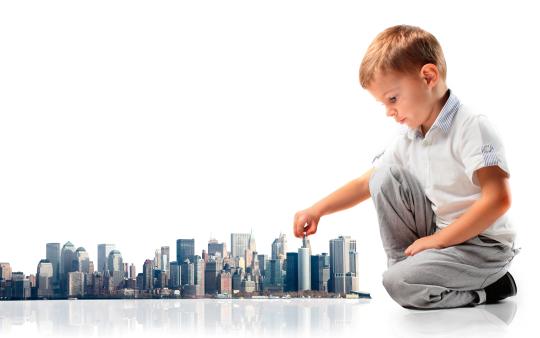A reader wrote to me that she and her family had just moved back to Canada after a few years living in Iceland. While they were happy to be back closer to their families, she really missed the quality of life they had there. She used to leave her baby sleeping in her stroller while she went into a shop! Everybody did. Life seemed safe and, in some ways, easier. Now they are living outside Toronto, trying to figure out where to settle in Canada, and she craves someplace to live that feels that safe and family-friendly.
As an immigrant myself, I often find myself comparing Canadian cities and communities to others I’ve known around the world. And because I also have a background in community planning, I like to look at the design reasons behind how we experience our communities. So, while I can’t tell anyone where to live, I can say a bit more about how children benefit from living in cities and how to start thinking like a designer when critiquing whatever community you choose to call home.
The health benefits of good urban neighbourhoods
I am lucky enough to rent a house in a diverse urban neighbourhood that faces onto a park and playground. I didn’t know how much it would affect my life when we moved here, but it has been transformative. Both my children have friends they have met at that park and the two of them will go and play out there without me. I can look out the window and see that they are okay and continue my work. Because the playground is surrounded by other homes, artists’ studios, and even a few businesses, I know that there are always neighbours around to help, if needed, as well. And I like that in this park they meet children and adults that look very different from them and for whom English is not the primary language spoken. It feels like a traditional neighbourhood – once common in Canada, but now the exception.
The very structure of how our communities are designed in North America now makes it rare to find a neighbourhood or town where the majority of children walk or bike to and from school on their own, play unsupervised with other children in the park and know most of their neighbours. Not only does this mean we wouldn’t leave our babies alone in strollers, it may be affecting our health. People who live in traditional, mixed-use, pedestrian-oriented communities like I just described are more likely, says Dr. Kevin Leyden, “…to know their neighbours, participate politically, trust others, and be socially engaged.” This is called having “high social capital” and people who have it tend to “live longer and be healthier physically and mentally” than their counterparts in more car-dependent suburban communities, according to Leyden’s research published in the American Journal of Public Health.
In North America we often think that having kids necessitates moving to the suburbs. Yet, the Leyden study isn’t the only one suggesting we may be better off doing the opposite. Research published in the Journal of Development and Psychopathology suggests that middle-class kids in the suburbs are at a greater risk of illicit drug use, depression, and bouts of misbehaviour than their inner-city counterparts. And kids who live more rurally are at greater risk of dying in automobile accidents, which is the number one killer of Canadian youth, than their more urban counterparts.
Designing urban neighbourhoods for kids
If suburbs are failing to provide families the health, safety, and community they want, then how do we get more from our cities and towns? You design for kids!
“If you make a great place for children to live, it will be a great place for everyone”
This is according to Dr. Rae Bridgman, Professor in the Department of City Planning at University of Manitoba, where she teaches a class on designing kid-friendly cities. One undeniable example of this comes in the form of transportation design. “Kids can’t drive cars. They can walk and take bikes. Our cities need to accommodate all these forms of transportation,” says Dr. Bridgman. What can work for youth can also work for the elderly. A parent navigating sidewalks and buses with a stroller gets a tiny taste of the complexity of navigating life with a wheelchair or walker. While one may not see the elderly as often riding bicycles, a system of bike lanes that accommodates parents with kids is one that can also attract older riders as well as provide safe routes for electric powered wheelchairs. As well, providing an interconnected system for pedestrian access to patches of green space, waterfront parks and playgrounds means that children and the elderly will be able to access, use and feel safe in spaces that might otherwise be under-utilized.
Even though kid-friendly transportation design is so inherent to creating vibrant, accessible communities, it seems that most are failing to do it. Kids used to walk to school on their own and ride their bikes to the corner store. Indeed, when we were young, almost 60 percent of us walked or rode to school. Today, however, only 28 percent of kids do this, according to Active Healthy Kids Canada. They give Canadian children a failing grade overall when it comes to maintaining a healthy amount of active movement.
Creating opportunities for children to be active and playful amidst daily life – such as safe walking routes to school, accessible playgrounds for all ages, and accessible transit – is essential to having communities that feel child-friendly. And the changes don’t always have to be big, capital projects. Dr. Bridgman gives an example that one of her graduate students is working on called “Play Finding”. The idea is to create way-finding strategies to help kids navigate and come to know their urban environments. They learn to recognize places, statues and know the history of their cities. “These kids will want to help and protect their city and the next generation,” says Dr. Bridgman. While creating Play Finding in our communities is relatively simple, the idea presupposes something very important and possibly controversial: that kids should be allowed outside and in our public spaces by themselves.
Avoid replacing play with “safety”
Encouraging play, and thus challenging the growing culture of “safety paranoia”, also known as “risk aversion”, is essential for creating healthy childhoods, say a growing number of child development experts such as Cris Rowan, a paediatric occupational therapist-cum-community play consultant and author of Virtual Child: The terrifying truth about what technology is doing to children. “We are trading in child development for perceived safety,” she warns. Perhaps it’s a chicken and egg scenario: which came first – the paranoia or the lack of play? Whatever the answer, it’s clear that kids today are not getting anywhere near enough of the play they need for healthy, normal development. Children only get an average of a half hour of unstructured outdoor play a day – less than half of what they got just 20 years ago – and nowhere near the three hours of rough and tumble play that young children need according to experts like Rowan.
The research suggests that both active and imaginative play are essential in developing language and math skills and in developing “executive function,” which is a greater indicator of a child’s future academic success than IQ. Children of all ages and even adults benefit from play. It can be as effective as Ritalin for treating ADHD and experts such as Richard Louv, author of Last Child in the Woods, suggests that unstructured play in nature can have a curative effect on children suffering from all sorts of issues – even mental illness. Rowan says a well-designed playground will benefit most children’s learning more than any class, computer program or app. Play can help with every aspect of healing, relationship building, and creating community. Less studied, but also impactful, are the benefits of seeing others – especially children – playing. It is mentioned in community meetings as one of the things that people notice in neighbourhoods that feel safe and welcoming.
Public play spaces are disappearing
The most conspicuous examples are playgrounds and play spaces for older children. In Ontario, a group of nonprofits, researchers, and other institutions have joined forces to create Play Works whose goal is to bring back the power of play to Ontario youth and to advance the conversation in the political realm about the importance of play for teenagers. Louv points out that access to public play spaces and safe routes for kids to get around is an equity issue. It shouldn’t just be the children of one ethnic group, class or even those who have parents who simply value nature more, that get to experience daily play. “Every child needs nature,” says Louv.
Rowan emphasizes that there needs to be places in communities for all children to play and that encourage age-appropriate play – the kind essential to the development of the entire child – for ages 0 to 3, 4 to 7, 8 to 12, and 13 to 18. Once parents start looking around with the “critical eye of a designer,” as Dr. Bridgman calls it, they quickly come to the same conclusion that experts such as Rowan and the Play Works people have: there are almost no age-appropriate play areas for youth over the age of eight. This means places where they will be challenged physically and appropriately–high climbing walls, 40-degree angles, bars and hanging equipment. Rowan also recommends exercise equipment for adults located near the little kid play areas so that adults are moving while they are watching children play rather than zoning out on mobile devices and further modelling a behaviour that she says is a big part of the problem.
Both Rowan and Dr. Bridgman emphasize that designing cities for families, and notably here in Canada, also means designing well for their winters. A number of North American cities have come up with inspirational examples – think the ice-skating canals in cities like Ottawa – where families can ice-skate to school and work, the Emera Oval for free outdoor skating in Halifax, Chicago's free Lincoln Park Zoo and conservatory where families can warm up and play in the heart of the city’s largest park and the many urban nature preserves-cum-accessible winter play-lands with cross country skiing, sledding hills, snowshoeing opportunities, and a cart selling hot chocolate.
One of the communities Rowan worked with is Bella Bella, in northern British Columbia. “It rains, there are wolves and bears, it's dark.” In other words, sometimes there needs to be indoor play spaces too. So they created one called “Crash and Bump” with bouncy castles, suspended equipment and obstacle courses. “A place where kids can just run and that is sensory, motor and attachment rich.”
How can you tell if a community is kid-friendly?
There is nobody out there keeping a master list of great, kid-friendly cities. As UNICEF says in the preamble to their Urban (U)-Kid Index, “Detailed standardized data on the conditions for children in cities is often lacking,” as are indicators for comparing different cities and communities around the world. Their index looks at data in four key categories: a good start to life, protection from harm, education and knowledge, and standard of living.
Perhaps more relevant to most North American families is the Youthful Cities ranking that looks worldwide at 80 indicators in 16 categories to assess quality of life for youth. They include such things as diversity, access to bike rentals, kilometres of bike path per capita, walkability, access to education and post-secondary institutions, carbon footprint, number of public libraries per capita, and getaway city transportation costs. Toronto topped the list as the world’s most Youthful City in 2014. Toronto was the only Canadian city to be included and make the top twenty list. Berlin ranked #2 and New York City rated #3. In 2015, Toronto, Vancouver, and Montreal made the list, with New York (#1), London (#2), and Berlin (#3) making the top 3.
“A city that allows children to feel safe, cherished, to play, and to enjoy living in the city as much as their parents do…” is a kid-friendly city, says Dr. Bridgman. To some extent it is one of those things that you know when you experience it. The Scandinavian countries are models in providing a certain type of support for families such as paid maternity and paternity leave, baby-friendly hospitals, and subsidized childcare. Countries like Denmark and the Netherlands are known for their bike culture where it is easy for all ages and all types to bike and walk everywhere. And all of these Northern European countries are excellent in the creation of playgrounds (and often awesome outdoor play gear) because they believe that children should be outside playing in all weather. Places like France emphasize healthy and interesting food served hot in every school and childcare facility. Sometimes, it’s just simple things that stand out like the newer trains and buses in some cities that make it easier for parents to ride without unloading their kids from the stroller or the groceries from the cart. New York City, the epitome of "city-ness", boasts many neighbourhoods well-suited to young families. Some cities have begun to include children in participatory processes; one such example is Vancouver, who just invited youth to sit on the city council’s Children, Youth and Families Advisory Committee. And then there is Toronto, a consistently Youthful City. While this list may seem disparate – from maternity leave to youth councils – all are examples that put the well-being of children front and centre in their policy and planning in some respect.
Dr. Bridgman says that just about any university town can be relatively kid-friendly with its diverse population, access to cultural amenities, great libraries, nature and play spaces, and good transportation options. And she says her favourite kid-friendly small town is Victoria Beach, Manitoba. “People leave their cars – 2,000 plus – in the parking lot by the front gateway,” during the summer months and then get around on foot. She continues, “The scale of the place is small and family-oriented,” and “…kids can walk, run, and bike freely.”
10 questions to ask of a public space
There are ten questions Dr. Bridgman encourages people to ask of all their public spaces. These questions can help parents think like designers when they are at a community meeting or when they are sitting in a playground wondering why it doesn't feel quite right. With the help of such engaged parents, Canadian communities can become more kid-friendly and better serve all its citizens.
- Are there places for all children to play?
- Do children have clean air to breathe?
- Are there drinking fountains and public toilets for children to use?
- Do children enjoy touching buildings’ materials, textures and finishes? (Have traces been left by their touch?)
- Can you hear special sounds in the space (wind rustling through leaves, bird song, children’s calls, human laughter)?
- Does this place help children understand the change of the seasons?
- Is there shelter from hot sun, rain, the north wind’s chill?
- Are there safe routes if children want to walk or bicycle or take a bus? Are children safe from traffic?
- If children need help or someone is trying to hurt them, will people run to help?
- How are children’s ideas for designing and improving public spaces heard and incorporated into decision-making?
How to make your community more kid-friendly
You don’t have to move to get a more kid-friendly community. Or, if you do move, you don't have to move to Victoria Beach. My friend Maureen Gainer moved her family of six to a more walkable neighbourhood in their same city specifically so she could allow her kids to walk to school on their own. The first day, she worried. On the second day, one of the other mothers on the street stopped by to ask about her decision to let them walk alone. And by the second week, two other families started letting their kids do it too.
There are a variety of ways to help your existing community become better at meeting the needs of all ages. These include creating transportation options such as walking and biking routes that connect where people live and where they go to school, work, and play; accessible outdoor and indoor play spaces that meet the play needs of young children, older children and even adults; and occasions for people of all ages to have fun and celebrate together. While it is noble to have parents advocating for large-scale opportunities, it’s also valuable to pursue the small things: closing off your street once a year for a neighbourhood block party, asking the city to consider equipment for older children and adults at the playground or changing your routine in order to walk your kid to school so that they can begin to do it themselves one day. As parents we instinctively know and the research assures us these little steps add up to health benefits, security, and general well-being for your children and the whole community.
Check it out!
- Last Child in the Woods by Richard Louv
- Youthful Cities https://www.youthfulcities.com/
- UNICEF Child Friendly Cities Initiative https://childfriendlycities.org/
- UNICEF Building Child Friendly Cities: A framework for action https://www.unicef-irc.org/publications/pdf/cfc-framework-eng.pdf



